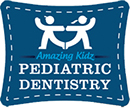Enjoy these kids dental tips! Good dental habits begin very early in life.
 Your child’s first tooth usually erupts between the age of 6-12 months and the remainder of their 20 primary or “baby” teeth typically erupt by age 3. During this teething time, the gums may feel tender and sore, causing your child to be irritable. To help alleviate this discomfort, we recommend that you soothe the gums by rubbing a clean finger or a cool, wet cloth across them. You may also choose to make use of a cold child safe teething ring. Your child’s primary teeth are shed at various times throughout childhood, and their permanent teeth begin erupting normally around 6 years old and continue until age 21.
Your child’s first tooth usually erupts between the age of 6-12 months and the remainder of their 20 primary or “baby” teeth typically erupt by age 3. During this teething time, the gums may feel tender and sore, causing your child to be irritable. To help alleviate this discomfort, we recommend that you soothe the gums by rubbing a clean finger or a cool, wet cloth across them. You may also choose to make use of a cold child safe teething ring. Your child’s primary teeth are shed at various times throughout childhood, and their permanent teeth begin erupting normally around 6 years old and continue until age 21.
Begin brushing with a small, soft bristled toothbrush as soon as the first tooth appears
Toothpaste is not necessary at this stage since it is actually the way we brush that removes the plaque and debris in our mouth. If used, only a rice sized smear of toothpaste specially formulated for children is appropriate. It is not uncommon for children to want to eat the toothpaste making your help and supervision extra important. Brushing is a fine motor skill and a difficult habit to do well. We recommend your child have help brushing until age 7 years old.
Brush your baby’s teeth after each feeding
Baby bottle decay is caused by putting the baby in bed with anything except water such as a bottle of milk, formula, juice, etc. The best way to prevent cavities is to brush well and keep the sugars in their diet to a minimum. If you notice darkened spots on their teeth or other signs of decay, contact Dr. Shults immediately.
Examine new teeth
As new teeth appear, examine them every two weeks for spots or discoloration caused by decay or developmental disturbances. Keep in mind that acids made from sugary foods and liquids can attack a new tooth causing a cavity.
Dr. Shults recommends brushing three times a day for optimal oral hygiene: after breakfast, after lunch, and before bedtime. Brushing can be made fun! Dr. Shults will review proper tooth brushing techniques with you and your child.
Brushing: Step 1
Place your toothbrush on the teeth at a 45-degree angle towards the gum tissue.
Brushing: Step 2
Brush gently on each tooth in a circular motion.
Brushing: Step 3
Separately brush the outer cheek surface, inner tongue surface, and all of the chewing surfaces of each tooth.
Brushing: Step 4
Use the tip of your brush for the inner surface of your front teeth to maintain that 45-degree angle.
Flossing
Flossing is also an important part of good oral hygiene, and Dr. Shults will discuss with you the right technique and time to start flossing.
Flossing: Step 1
Start with about 18 inches of floss wrapped around your 2 pointer or middle fingers leaving about 1-1.5 inches in between. Most of it should be wrapped around one finger, allowing the used segments of floss to shift to the other finger. Floss picks can also be used when trying to fit into smaller spaces like your young child’s mouth.
Flossing: Step 2
Use your thumbs and forefingers to guide about one inch of floss between your teeth.
Flossing: Step 3
Holding the floss tightly between the fingers gently seesaw the floss between your teeth. Then curve the floss into a C-shape against one tooth and gently slide it down the side of the tooth from where the teeth touch to just beneath your gums.
Flossing: Step 4
Slide the floss up and down from where the teeth touch to the gum line, repeating for each tooth.
Remember these kids dental tips:
- Limit sugary drinks and snacks, especially in between meals and before bedtime or naptime. If something is needed only water should be given in bed to prevent cavities.
- Establish good brushing and flossing habits early on.
- Make sure your child gets regular dental checkups at least every 6 months if possible.
- Call Dr. Shults immediately if your child has any injury involving their mouth. Our office number is 480.634.5686.
